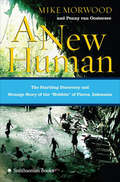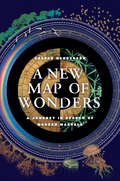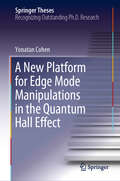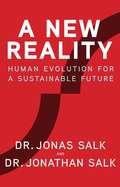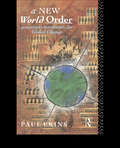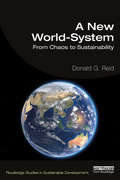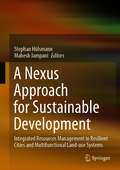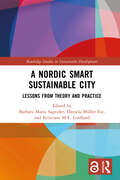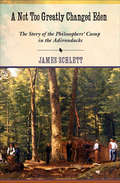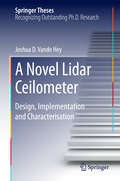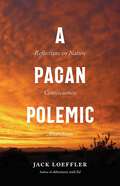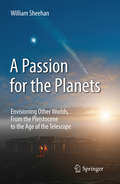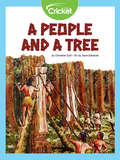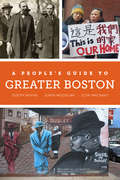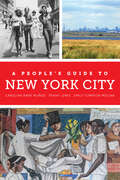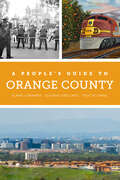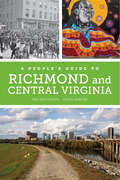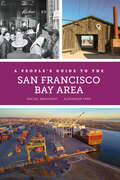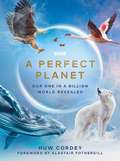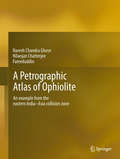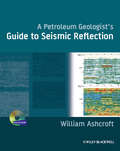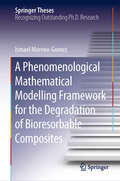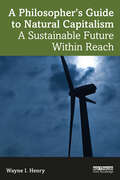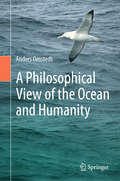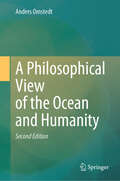- Table View
- List View
A New Human: The Startling Discovery and Strange Story of the "Hobbits" of Flores, Indonesia
by Mike Morwood Penny Van OosterzeeIn October 2004, a team of Australian and Indonesian anthropologists led by Mike Morwood and Raden Pandji Soejono stunned the world with their announcement of the discovery of the first example of a new species of human, Homo floresiensis, which they nicknamed the "Hobbit." This was no creation of Tolkien's fantasy, however, but a tool-using, fire-making, cooperatively hunting person. The more Morwood and his colleagues revealed about the find, the more astonishing it became: standing only three feet tall with brains a little larger than a can of cola, the Hobbits forced anthropologists and everyone to reconsider what it means to be human.Morwood's work was no ordinary academic exercise. Along the way he had to tread warily through the cultural landscape of Indonesia—he has an embarrassing mishap with some hard-to-chew pork—and he demonstrated that sometimes the life of a real archaeologist can be a bit like Indiana Jones's when he risked his neck in an ocean-going raft to experience how ancient Indonesians might have navigated the archipelago. Even more, Morwood had to navigate the rock shoals of an archaeological bureaucracy that could be obtuse and even spiteful, and when the Hobbits became embroiled in scientific controversy—as no find of such magnitude could avoid—it proved easy for Morwood to get nearly swamped with trouble. Finds were stolen and damaged, and the backbiting was fierce. But the light of science, once brightened, is difficult to dim, and the story of the indefatigable Morwood's fight to defend his find discovery is an inspiration.
A New Map of Wonders: A Journey in Search of Modern Marvels
by Caspar Henderson“Henderson teaches us how to wonder anew with a new vision of science illuminated by a rich range of literature, philosophy, art, and music.” —Hugh Aldersey-Williams, author of Dutch LightWe live in a world that is known, every corner thoroughly explored. But has this knowledge cost us the ability to wonder? Wonder, Caspar Henderson argues, is at its most supremely valuable in just such a world because it reaffirms our humanity and gives us hope for the future. That’s the power of wonder, and that’s what we should aim to cultivate in our lives. But what are the wonders of the modern world?Henderson’s brilliant exploration borrows from the form of one of the oldest and most widely known sources of wonder: maps. Large, detailed mappae mundi invited people in medieval Europe to vividly imagine places and possibilities they had never seen before: manticores with the head of a man, the body of a lion, and the stinging tail of a scorpion; tribes of one-eyed men who fought griffins for diamonds; and fearsome Scythian warriors who drank the blood of their enemies from their skulls. A New Map of Wonders explores these and other realms of the wonderful, in different times and cultures and in the present day, taking readers from Aboriginal Australian landscapes to sacred sites in Great Britain, all the while keeping sight questions such as the cognitive basis of wonder and the relationship between wonder and science.Beautifully illustrated and written with wit and moral complexity, this sequel to The Book of Barely Imagined Beings is a fascinating account of the power of wonder and an unforgettable meditation on its importance to our future.
A New Platform for Edge Mode Manipulations in the Quantum Hall Effect (Springer Theses)
by Yonatan CohenIn the last several decades, the quantum Hall effect has provided a remarkable platform for manipulating one-dimensional electronic modes and investigating fundamental physical phenomena. However, certain limitations make it difficult for various kinds of interesting modes structures to be formed using this platform. One example is the so called helical mode structure, in which two one-dimensional, counter propagating modes have opposite spins and thus spin and momentum are locked. Such helical modes have lately attracted significant interest, since, when coupled to a conventional superconductor, they are expected to manifest topological superconductivity and host Majorana zero modes. Even more interesting are fractional helical modes, which open the way for realizing generalized parafermionic zero modes. Possessing non-abelian exchange statistics, these quasiparticles may serve as building blocks in topological quantum computing. Here we present a new platform for manipulating integer and fractional quantum Hall edge modes, which allows the formation of robust one-dimensional helical as well as fractional helical modes. The platform is based on a carefully designed double-quantum-well structure in a GaAs based system hosting two electronic sub-bands in the quantum Hall effect regime. By electrostatic gating of different areas of the structure, counter-propagating integer, as well as fractional, edge modes with opposite spins are formed and their spin protection is verified. Beyond the formation of helical modes, the new platform can serve as a rich playground for new research. Some new possibilities include the artificial induction of compounded fractional edge modes and the construction of new edge mode-based interferometers.
A New Reality: Human Evolution for a Sustainable Future
by Jonas Salk Jonathan Salk David Dewane Elizabeth H BlackburnA New Reality: Human Evolution for a Sustainable Future provides a startling, fresh new message of understanding, perspective and hope for today’s tense, rapid-fire, kaleidoscopically changing world. A New Reality: Human Evolution for a Sustainable Future provides a startling, fresh new message of understanding, perspective and hope for today’s tense, rapid-fire, kaleidoscopically changing world. Drawn from the writings of visionary scientist Jonas Salk, who developed the polio vaccine, extended and developed by his son Jonathan, the message of the book explodes from the past and sheds light on tensions that besiege us and the currents of discord that are raging as these words are written. More importantly, it indicates a way forward out of our current situation. Written by a world-famous doctor and folk hero, based on population data, rich in visual imagery, elegantly designed, and clearly written, A New Reality is unique in the marketplace. Readable in one or two sittings, it is accessible to the general reader while at the same time being of essential value to policy makers and academics. Its brevity and simplicity of design belie the importance and sophistication of its message. “We are at a point in the course of human social evolution when the demands of survival converge with the higher ideals of humankind and the well-being and flourishing of human society. It is up to us to see that we navigate this transition, adapting to and emerging in a new reality.” —A New Reality Our country is divided and polarized. Terrorism is a major threat throughout much of the world. Mass migrations are causing national and international tension. Population growth continues to increase, especially in the developing regions of the world. Controversy rages as to the use of fossil fuels versus the development of alternative forms of energy. Disagreement continues about climate change. Opposing currents of opinion collide as to how much we should help other areas in the world and how much to help ourselves. Basic values are in conflict. More than 40 years ago, Jonas Salk understood that we are at a unique moment in the history of the human species. After centuries of increase, population growth has begun to slow and is trending toward equilibrium. This change is accompanied by an equally significant change in human values—a shift from those based on unlimited availability of resources, unremitting growth, excess, independence, competition and short-term thinking to those based on limits, equilibrium, balance, interdependence, cooperation and long-term thinking. This momentous transition is the source of far-reaching tension and conflict. The way through this difficult era is to understand its basis and to focus on new values that will be of the greatest benefit to humankind. There is an urgency, however, and failure to adapt will result in disaster both for humanity and for the planet as a whole. A New Reality delivers a message of both caution and hope. Readers across the social and political spectrum will find it a reasoned and balanced counterpoint to current social and political trends. Its elegant design and long-range perspective will appeal to general readers, policy makers, millennials, baby boomers, teachers, and students, filling a need in the marketplace for a work of positivity and wisdom in otherwise bleak times.
A New World Order: Grassroots Movements for Global Change
by Paul EkinsFirst published in 1992. Routledge is an imprint of Taylor & Francis, an informa company.
A New World-System: From Chaos to Sustainability (Routledge Studies in Sustainable Development)
by Donald G. ReidA New World-System: From Chaos to Sustainability examines the present crisis in the social and ecological environment that is producing profound, potentially catastrophic challenges to the planet and humanity and outlines a process for moving forward to address these critical issues. This book is a cautionary interpretation of the present and vision for the future. Unlike other books on this or allied subjects that are focused singularly, Part 1 surveys the five major threats facing humanity today: climate change, inequality and poverty, new technologies, migration, and globalization. It approaches the challenge of integrating these phenomena into a global picture from a systems perspective rather than taking a purely reductionist approach to understanding what is occurring in the world today. Part 2 moves from identifying the problems to solving them, with chapters examining the ability of the present world-system to address these issues and outlining a process for action. The book concludes by discussing what could follow capitalism as a social organizing strategy and, perhaps more importantly, the consequences to the planet if we do not construct a new world-system. This book is essential reading for students and scholars of sustainable development, climate change, environmental studies, rural and urban planning, environmental psychology, political economy, sociology, social policy, leisure studies, and environmental politics. More broadly, it is a vital resource for all those interested in building a sustainable society.
A Nexus Approach for Sustainable Development: Integrated Resources Management in Resilient Cities and Multifunctional Land-use Systems
by Stephan Hülsmann Mahesh JampaniThis book explores how integrated management of environmental resources via a nexus approach can help in achieving the respective Sustainable Development Goals (SDGs). It provides conceptual considerations but mainly practical examples on how to implement a nexus approach in cities and multifunctional land-use systems to increase resource use efficiency and develop a low carbon economy. After sketching out the background and conceptual outline, contributions to the book explore key aspects of the nexus implementation. Specifically, they • Demonstrate how to sustainably use organic waste and wastewater for agriculture, • Explore examples on how to manage multifunctional land-use systems including multipurpose reservoirs, • Highlight the importance of economic incentives for successful nexus implementation, and • Provide a comprehensive perspective on challenges and opportunities of implementation, considering peer-to-peer learning, indigenous knowledge, and stakeholder participation. The chapters in this book shed a new light on key aspects of the interrelation between SDGs and the nexus approach in resilient cities and multifunctional land-use systems, and provide specific examples on how to advance sustainable resources management.
A Nordic Smart Sustainable City: Lessons from Theory and Practice (Routledge Studies in Sustainable Development)
by Barbara Maria SageidetThis book critically explores research and development on the smart sustainable city, emphasizing the tension and association between smartness and sustainability, both as a concept and as a phenomenon in a Nordic context.Worldwide, increasing urbanization and its related challenges, along with urgent environmental issues, have sped up the international interest for smart, sustainable cities as a concept that could increase the efficiency of services, minimize environmental impacts, and improve the quality of living in cities and urban areas. This book scientifically discusses the provenance, substance, and processes of the smart sustainable city, with illustrative examples of how it is translated into urban realities in a medium-sized city, drawing upon Stavanger, one of the first, and one of the leading smart sustainable cities in Europe. The book’s multidisciplinary perspectives and thematic lenses include education and knowledge, arts and culture, safety, climate and sustainability, mobility and transport, economics, democracy, participation, innovation and entrepreneurship, data, and communication. While demonstrating the academic breadth and wide-ranging impact of the smart sustainable city concept, the book promotes and updates the ground for mutual understanding, communication, and collaboration between multiple disciplines and stakeholders involved in developing functional, democratic, and sustainable solutions for the urban present and future.A Nordic Smart Sustainable City: Lessons from Theory and Practice presents an overview of scientific and practical current approaches in a readable format for practitioners and administrators in municipalities and related businesses, for researchers, academics, educators, students, and stakeholders.
A Not Too Greatly Changed Eden: The Story of the Philosophers’ Camp in the Adirondacks
by James SchlettIn August 1858, William James Stillman, a painter and founding editor of the acclaimed but short-lived art journal The Crayon, organized a camping expedition for some of America's preeminent intellectuals to Follensby Pond in the Adirondacks. Dubbed the "Philosophers' Camp," the trip included the Swiss American scientist and Harvard College professor Jean Louis Rodolphe Agassiz, the Republican lawyer and future U.S. attorney general Ebenezer Rockwood Hoar, the Cambridge poet James Russell Lowell, and the transcendental philosopher Ralph Waldo Emerson, who would later pen a poem about the experience. News that these cultured men were living like "Sacs and Sioux" in the wilderness appeared in newspapers across the nation and helped fuel a widespread interest in exploring the Adirondacks. In this book, James Schlett recounts the story of the Philosophers' Camp, from the lives and careers of--and friendships and frictions among--the participants to the extensive preparations for the expedition and the several-day encampment to its lasting legacy. Schlett's account is a sweeping tale that provides vistas of the dramatically changing landscapes of the United States in the second half of the nineteenth century. As he relates, the scholars later formed an Adirondack Club that set out to establish a permanent encampment at nearby Ampersand Pond. Their plans, however, were dashed amid the outbreak of the Civil War and the advancement of civilization into a wilderness that Stillman described as "a not too greatly changed Eden." But the Adirondacks were indeed changing. When Stillman returned to the site of the Philosophers' Camp in 1884, he found the woods around Follensby had been disfigured by tourists. Development, industrialization, and commercialization had transformed the Adirondack wilderness as they would nearly every other aspect of the American landscape. Such devastation would later inspire conservationists to establish Adirondack Park in 1892. At the close of the book, Schlett looks at the preservation of Follensby Pond, now protected by the Nature Conservancy, and the camp site's potential integration into the Adirondack Forest Preserve.
A Novel Lidar Ceilometer: Design, Implementation and Characterisation (Springer Theses)
by Joshua D. Vande HeyIn this thesis, a new lidar (light detection and ranging) ceilometer capable of monitoring cloud base and sensitive to boundary layer aerosols is introduced. The key to this novelty lies in its divided-lens design that addresses a classical lidar problem of balancing transmitter-receiver overlap and signal-to-noise ratio, along with a method for characterizing overlap in the laboratory. Enhanced sensitivity in the near-range of the instrument is achieved without compromising signal-to-noise in a design that is straightforward to manufacture for broad deployment. The instrument, its optical characterization, and its performance in the field are described. The prototype instrument described here has since formed the basis of a commercial sensor for monitoring clouds and aerosols. High-resolution, continuous observations of clouds and aerosols are needed to reduce the large uncertainties in our current understanding of their influence on climate that have been highlighted by the International Panel on Climate Change. And as international health organizations indicate growing public health threats over the coming decades resulting from poor air quality, extensive aerosol monitoring is required to assess personal exposure to and the health impacts of anthropogenic particulates. Ground-based optical remote sensing measurements made by well-characterized instruments, such as that described in these pages, are critical to this.
A Pagan Polemic: Reflections on Nature, Consciousness, and Anarchism
by Jack LoefflerA Pagan Polemic curates the evolving perspective of Jack Loeffler—itinerant wanderer, environmental warrior, storyteller, and story collector—whose true education began when he was marched into the Nevada desert one day at dawn to play &“The Stars and Stripes Forever&” during an atomic bomb test a scant few miles away. Since that day in 1957, Jack&’s mission in life has been to record peoples of the borderlands and to bring &“Indigenous mindedness&” to the forefront of the conversation about our precarious environments and our decaying planet. A Pagan Polemic is a sweeping manifesto of Jack&’s core beliefs and long experience as a fierce (and funny) advocate for Nature and Nature-mindedness and against poisonous politics and policies.
A Passion for the Planets: Envisioning Other Worlds, From the Pleistocene to the Age of the Telescope
by William SheehanAstronomy is by far the most popular of the physical sciences, enticing enough to become a major cultural preoccupation for many, and for some an enthralling scientific activity which veritably rules their lives. What is the nature of that seemingly unstoppable attraction? In this lively and compelling account, William Sheehan - professional psychiatrist, noted historian of astronomy, and incurable observer - explores the nature of that allure through the story of man's visual exploration of the planets. In this volume, the first of a trilogy, Sheehan starts with observational astronomy's profound and lasting effect on his own life, setting the points of embarkation for the journey to come. He travels across the historical landscape seeking the earliest origins of man's compulsion to observe the planets among the hunter gatherers of the upper palaeolithic, and traces the evolving story from the planetary records of the earliest cities, to Pharonic Egypt through to Hellenistic Greek astronomy culminating in Ptolemy. The necessity to observe played its part in the perceptual changes wrought by the Copernican revolution, as well as the observational advances achieved by such extraordinary characters as Tycho with his sharpest of eyes, and his luxurious practice of total astronomy. The two epochal advances published in 1609, both born through planetary observation, namely Kepler's discovery of the true nature of the orbit of Mars and Harriot and Galileo's observations of the Moon, have a pivotal place in this account. Sheehan weaves a rich tapestry of social and technological settings, patronage and personalities, equipment and skills, cosmologies and goals, motives and compulsions to try to explain why we have observed, and continue to observe, the planets. The compelling text of A Passion for the Planets is enhanced by the specially commissioned planetary artwork of Julian Baum, himself son of a noted planetary observer and historian of planetary observers, and Randall Rosenfeld. A Passion for the Planets will be of interest to all amateur astronomers; active planetary observers; armchair astronomers; those interested in the history of astronomy; the cultural history of science; and astronomical art.
A People and a Tree
by Christine GrafNative American tribes from the Northwest Coast learned to use the wood of cedar trees for many of their daily needs. Tribes used recycling to conserve resources hundreds of years ago. Pounding bark until it was fluffy to make diapers and with special thin branches called withes, cedar trees were soaked and used to make rope. What special technique did tribes use to take down big cedar trees?
A People's Guide to Greater Boston (A People's Guide Series #2)
by Joseph Nevins Suren Moodliar Eleni MacrakisA People's Guide to Greater Boston reveals the region’s richness and vibrancy in ways that are neglected by traditional area guidebooks and obscured by many tourist destinations. Affirming the hopes, interests, and struggles of individuals and groups on the receiving end of unjust forms of power, the book showcases the ground-level forces shaping the city. Uncovering stories and places central to people’s lives over centuries, this guide takes readers to sites of oppression, resistance, organizing, and transformation in Boston and outlying neighborhoods and municipalities—from Lawrence, Lowell, and Lynn to Concord and Plymouth. It highlights tales of the places and people involved in movements to abolish slavery; to end war and militarism; to achieve Native sovereignty, racial equity, gender justice, and sexual liberation; and to secure workers’ rights. In so doing, this one-of-a-kind guide points the way to a radically democratic Greater Boston, one that sparks social and environmental justice and inclusivity for all.
A People's Guide to New York City (A People's Guide Series #5)
by Penny Lewis Emily Tumpson Molina Carolina Bank MuñozThis alternative guidebook for one of the world’s most popular tourist destinations explores all five boroughs to reveal a people’s New York City. The sites and stories of A People’s Guide to New York City shift our perception of what defines New York, placing the passion, determination, defeats, and victories of its people at the core. Delving into the histories of New York's five boroughs, you will encounter enslaved Africans in revolt, women marching for equality, workers on strike, musicians and performers claiming streets for their art, and neighbors organizing against landfills and industrial toxins and in support of affordable housing and public schools. The streetscapes that emerge from these groups' struggles bear the traces, and this book shows you where to look to find them. New York City is a preeminent global city, serving as the headquarters for hundreds of multinational firms and a world-renowned cultural hub for fashion, art, and music. It is among the most multicultural cities in the world and also one of the most segregated cities in the United States. The people that make this global city function—immigrants, people of color, and the working classes—reside largely in the so-called outer boroughs, outside the corporations, neon, and skyscrapers of Manhattan. A People’s Guide to New York City expands the scope and scale of traditional guidebooks, providing an equitable exploration of the diverse communities throughout the city. Through the stories of over 150 sites across the Bronx, Manhattan, Queens, Brooklyn and Staten Island as well as thematic tours and contemporary and archival photographs, a people’s New York emerges, one in which collective struggles for justice and freedom have shaped the very landscape of the city.
A People's Guide to Orange County (A People's Guide Series #4)
by Gustavo Arellano Thuy Vo Dang Elaine LewinnekThe full and fascinating guidebook that Orange County deserves.A People’s Guide to Orange County is an alternative tour guide that documents sites of oppression, resistance, struggle, and transformation in Orange County, California. Orange County is more than the well-known images on orange crate labels, the high-profile amusement parks of Disneyland and Knott’s Berry Farm, or the beaches. It is also a unique site of agricultural and suburban history, political conservatism in a liberal state, and more diversity and discordance than its pop-cultural images show. It is a space of important agricultural labor disputes, segregation and resistance to segregation, privatization and the struggle for public space, politicized religions, Cold War global migrations, vibrant youth cultures, and efforts for environmental justice. Memorably, Ronald Reagan called Orange County the place "where all the good Republicans go to die," but it is also the place where many working-class immigrants have come to live and work in its agricultural, military-industrial, and tourist service economies. Orange County is the fifth-most populous county in America. If it were a city, it would be the nation’s third-largest city; if it were a state, its population would make it larger than twenty-one other states. It attracts 42 million tourists annually. Yet Orange County tends to be a chapter or two squeezed into guidebooks to Los Angeles or Disneyland. Mainstream guidebooks focus on Orange County’s amusement parks and wealthy coastal communities, with side trips to palatial shopping malls. These guides skip over Orange County’s most heterogeneous half—the inland space, where most of its oranges were grown alongside oil derricks that kept the orange groves heated. Existing guidebooks render invisible the diverse people who have labored there. A People’s Guide to Orange County questions who gets to claim Orange County’s image, exposing the extraordinary stories embedded in the ordinary landscape.
A People's Guide to Richmond and Central Virginia (A People's Guide Series #6)
by Melissa Dawn OotenAn expansive guide for resistance and solidarity across this storied region. Richmond and Central Virginia are a historic epicenter of America’s racialized history. This alternative guidebook foregrounds diverse communities in the region who are mobilizing to dismantle oppressive systems and fundamentally transforming the space to live and thrive. Featuring personal reflections from activists, artists, and community leaders, this book eschews colonial monuments and confederate memorials to instead highlight movements, neighborhoods, landmarks, and gathering spaces that shape social justice struggles across the history of this rapidly growing area. The sites, stories, and events featured here reveal how community resistance and resilience remain firmly embedded in the region’s landscape. A People’s Guide to Richmond and Central Virginia counters the narrative that elites make history worth knowing, and sites worth visiting, by demonstrating how ordinary people come together to create more equitable futures.
A People's Guide to the San Francisco Bay Area (A People's Guide Series #3)
by Rachel Brahinsky Alexander TarrAn alternative history and geography of the Bay Area that highlights sites of oppression, resistance, and transformation.A People’s Guide to the San Francisco Bay Area looks beyond the mythologized image of San Francisco to the places where collective struggle has built the region. Countering romanticized commercial narratives about the Bay Area, geographers Rachel Brahinsky and Alexander Tarr highlight the cultural and economic landscape of indigenous resistance to colonial rule, radical interracial and cross-class organizing against housing discrimination and police violence, young people demanding economically and ecologically sustainable futures, and the often-unrecognized labor of farmworkers and everyday people.The book asks who had—and who has—the power to shape the geography of one of the most watched regions in the world. As Silicon Valley's wealth dramatically transforms the look and feel of every corner of the region, like bankers' wealth did in the past, what do we need to remember about the people and places that have made the Bay Area, with its rich political legacies? With over 100 sites that you can visit and learn from, this book demonstrates critical ways of reading the landscape itself for clues to these histories. A useful companion for travelers, educators, or longtime residents, this guide links multicultural streets and lush hills to suburban cul-de-sacs and wetlands, stretching from the North Bay to the South Bay, from the East Bay to San Francisco. Original maps help guide readers, and thematic tours offer starting points for creating your own routes through the region.
A Perfect Planet
by Huw CordeyThere is no place like home.The conditions of Earth are not just good for life, they are perfect. Everything about our planet - its size, its distance from the Sun, its spin and tilt, its moon - is perfectly suited to our existence, and our planet's forces serve to nurture its spectacular biodiversity. A Perfect Planet shows in stunning detail how Earth has always been more than the sum of its parts. Unlike any other astronomical body, it is a living world.Focusing on four key natural forces - global weather systems distributing fresh water to all corners; marine currents delivering nutrients to the deepest reaches of the ocean; solar energy warming and electrifying everything it touches; and volcanic activity fertilising the earth's surface - Huw Cordey reveals to us new levels of this living world, a place populated with astonishing characters living remarkable lives. From Arctic wolves prowling moonlit landscapes or wood frogs, frozen in winter and magically thawing back to life, to flamingos flying thousands of miles to a vast volcanic lake in Africa to breed, we see time and again how animals are perfectly adapted to whatever the environment throws at them.Packed with over 250 full-colour images, and including a foreword by Alastair Fothergill and stills from the BBC series' spectacular footage, A Perfect Planet is a stunning exploration of life on Earth - life that is increasingly precious and rare.
A Petrographic Atlas of Ophiolite: An example from the eastern India-Asia collision zone
by Naresh Chandra Ghose Nilanjan Chatterjee FareeduddinThe book is a thoughtful discussion with scientists studying convergent plate boundaries such as the well-known, active India-Eurasia collision zone. It provides a comprehensive collection of petrographic images of ophiolitic rocks exhumed from oceanic lithosphere and mantle at the India-Asia plate boundary. Ophiolite is exposed in the northwestern Himalayas, eastern Indian plate margin and Andaman-Nicobar Islands. At the eastern margin, it occurs in a narrow strip comprising mantle peridotite tectonite, cummulate peridotite-gabbro-plagiogranite-anorthosite, mafic dyke, volcanics and oceanic sediments. Low temperature/high pressure rocks including blueschists and eclogites were extensively studied recently. Ophiolite derived sediments and podiform chromites will also be discussed to provide complete details. Supplemental maps, geological sections, field sketches and photographs will explain the structure, stratigraphy, ore mineralization, and metamorphic history.
A Petroleum Geologist's Guide to Seismic Reflection
by William AshcroftThis book is written for advanced earth science students, geologists, petroleum engineers and others who want to get quickly 'up to speed' on the interpretation of reflection seismic data. It is a development of material given to students on the MSc course in Petroleum Geology at Aberdeen University and takes the form of a course manual rather than a systematic textbook. It can be used as a self-contained course for individual study, or as the basis for a class programme.The book clarifies those aspects of the subject that students tend to find difficult, and provides insights through practical tutorials which aim to reinforce and deepen understanding of key topics and provide the reader with a measure of feedback on progress. Some tutorials may only involve drawing simple diagrams, but many are computer-aided (PC based) with graphics output to give insight into key steps in seismic data processing or into the seismic response of some common geological scenarios. Part I of the book covers basic ideas and it ends with two tutorials in 2-D structural interpretation. Part II concentrates on the current seismic reflection contribution to reservoir studies, based on 3-D data.
A Phenomenological Mathematical Modelling Framework for the Degradation of Bioresorbable Composites (Springer Theses)
by Ismael Moreno-GomezThis book presents a generalised computational model for the degradation of resorbable composites, using analytic expressions to represent the interwoven phenomena present during degradation. It then combines this modelling framework with a comprehensive database of quantitative degradation data mined from existing literature and from novel experiments, to provide new insights into the interrelated factors controlling degradation. Resorbable composites made of biodegradable polyesters and calcium-based ceramics have significant therapeutic potential as tissue engineering scaffolds, as temporary implants and as drug-loaded matrices for controlled release. However, their degradation is complex and the rate of resorption depends on multiple connected factors such as the shape and size of the device, polymer chemistry and molecular weight, particle phase, size, volume fraction, distribution and pH-dependent dissolution properties. Understanding and ultimately predicting the degradation of resorbable composites is of central importance if we are to fully unlock the promise of these materials.
A Philosopher's Guide to Natural Capitalism: A Sustainable Future Within Reach
by Wayne I. HenryThis book posits that a sustainable future is possible without abandoning Capitalism. In its current form as Consumer Capitalism, the organization of the global economy is clearly unsustainable. But Capitalism is a malleable concept that has assumed a variety of forms since the 17th century, and it can be altered as needed. In Part I of this book, the author sets out an economic model for a sustainable form of Capitalism, referred to in the literature as Natural Capitalism. In Part II, he abandons exposition in favour of rigorous philosophical analysis and critiques the older but still dominant narrative that underlies Classical Liberalism. The narrative will be reconstructed with great care and analysed to understand why it has been so powerful and enduring, and, of course, why it is no longer appropriate for our current circumstances. In Part III, he investigates from a normative perspective Classical Liberalism and globalized Capitalism and the economic system it licenses. Finally, in the conclusion, the author draws the threads of the discussion together in a way that emphasizes the differences between the two narratives, Classical Liberalism on the one hand and the contemporary version of Progressive Liberalism that nurtures and supports Natural Capitalism on the other. This book will be of interest to a broad range of scholars and curious laypersons interested in a clear and interdisciplinary presentation of the issues arising out of climate change, including corporate governance, social and environmental policy, declining social capital and the capacity of democratic institutions to deal effectively with sustainability. It will be particularly relevant for students and instructors of philosophy, history, economics, political science, social policy and environmental sociology.
A Philosophical View of the Ocean and Humanity (Springerbriefs In Environmental Science Ser.)
by Anders OmstedtThis book is about the ocean and about the future. It is written in two modes, a concerned analytical scientific mode and an intuitive artistic mode in which the ocean is given a voice. The disconnect in the relationship between human dependency on and feelings about the ocean is examined in a dialogue between these two modes. The book illustrates how science and the arts can be connected to increase our awareness of the state of the ocean and support behavioural change. This book is intended for everyone who would like to contribute to the sustainable use of the ocean. Includes forewords by Alice Newton, University of Algarve, Portugal and Martin Visbeck, GEOMAR, Helmholtz Centre for Ocean Research, Kiel, Germany.
A Philosophical View of the Ocean and Humanity: Second Edition
by Anders OmstedtThis book provides an overview of major threats to our blue planet. But also tools for connecting facts and values to change our often destructive behavior towards nature. The solutions to achieving an ocean in harmony with man are within us, where compassion, curiosity, empathy, courage, and creativity are needed for sustainable change. Therefore, with this book, I want to arouse your curiosity and give the reader, the courage to face the future better by introducing tools for deep diving into our outer and inner world with many hidden resources. The book brings the reader into humans' challenges with the ocean and its future. It addresses some of the main questions in the United Nations Ocean Decade initiative that aims to change how humans deal with the ocean. This unique book will stimulate a broad way of thinking by connecting analytical science thinking and intuition. In the book's first part, art and dreams are used to connect science and art. This knowledge is then applied in part II of the book, written in two modes: a concerned science mode and an intuitive, artistic mode in which the ocean is given a voice. Part III illustrates how science and art can be connected to increase our awareness of the state of the ocean and support behavioral change.
